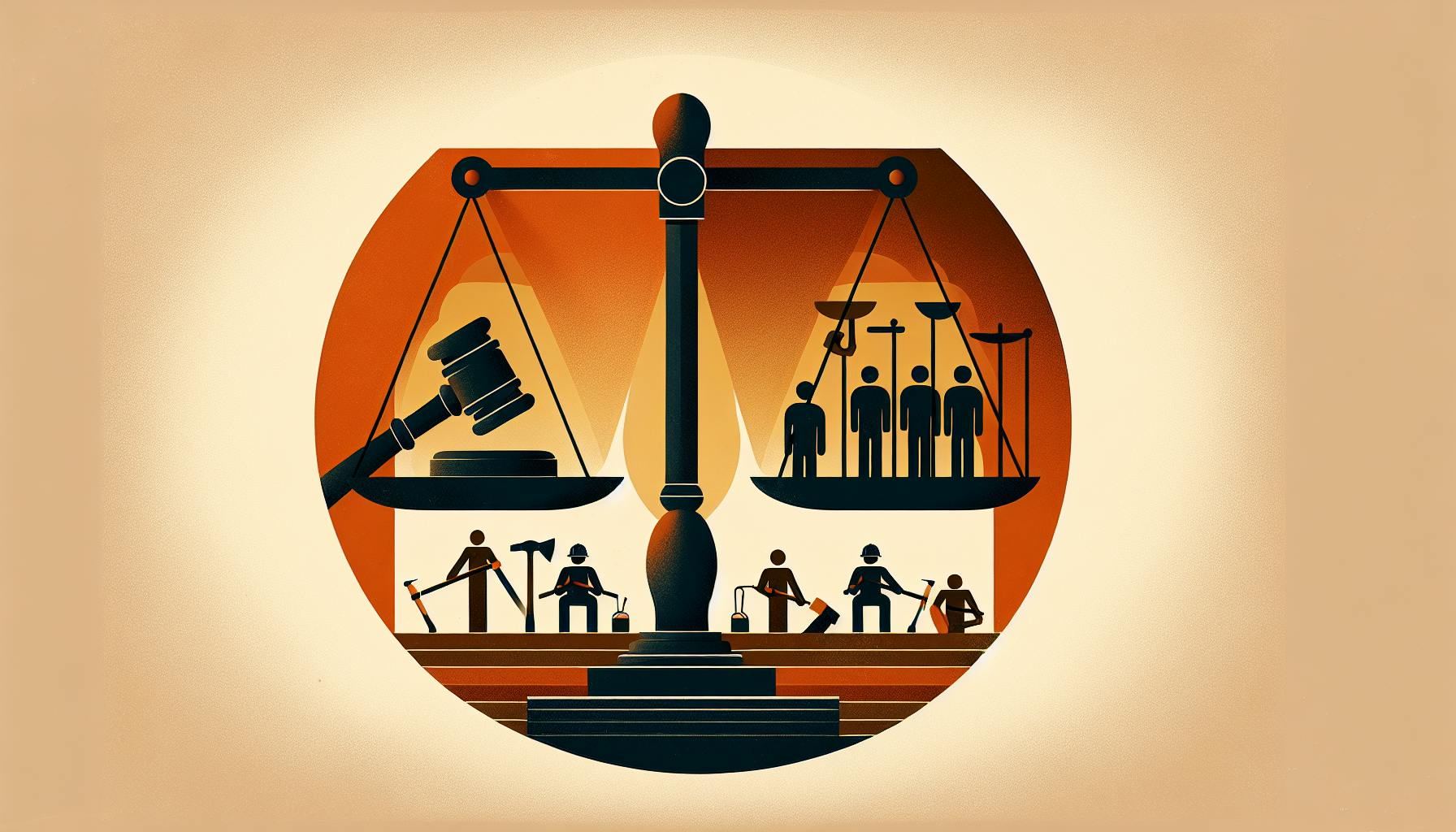Most legal professionals would agree that the concept of "error in objecto" in criminal law can be complex to grasp.
By explaining the key principles, tracing the historical roots, and providing real-world examples, this article will demystify this intricate legal concept.
You'll gain an in-depth understanding of what constitutes error in objecto, its implications in legal proceedings, and how courts treat this defense in sentencing and objections.
Introduction to Error In Objecto: A Legal Concept Unveiled
Error in objecto refers to a mistake regarding the identity of the victim or object against which a crime is committed. This legal concept relates to the intention and mental state of the perpetrator at the time of the criminal act.
Understanding the Legal Concept of Error In Objecto
Error in objecto, Latin for "error in the object", applies when the perpetrator directs their criminal actions towards an unintended victim or object, rather than their intended target. For example, if someone shoots at a person aiming to kill A, but accidentally kills B instead due to mistaken identity, this would constitute error in objecto.
The key distinction is between the actual victim/object and the intended or imagined one in the perpetrator's mind. Their subjective criminal intention is directed at the imagined target, even if the end result is harm to someone or something other than intended.
Tracing the Roots: The Historical Context of Error In Objecto
The legal notion of error in objecto has its roots in classical Roman law. The term first emerged in the "Corpus Juris Civilis" - the Body of Civil Law ordered by Emperor Justinian I in the 6th century AD.
The concept was further developed in the continental European legal tradition and formally incorporated into criminal statutes and judicial codes in several civil law countries. It continues to play an important role in assessing criminal culpability.
The Role of Error In Objecto in Criminal Law
Error in objecto relates to the mens rea (guilty mind) requirements in criminal law. The identity of the victim factors into assessments of the perpetrator's mental state and intentions at the time of the offense.
In some cases, error in objecto may provide grounds for reducing charges or mitigating sentences, particularly if the actual outcome significantly exceeded the perpetrator's intentions. However, its implications vary across different legal systems and cases.
The main purpose is to account for situations where unintended collateral damage occurs, while preserving the culpability for the intended criminal act. Error in objecto provides a framework for breaking down the complexities of human intention, action and consequence in criminal cases.
Subjective Intention and Error In Objecto
When error in objecto occurs, the subjective intention of the perpetrator remains directed against their imagined target, even if the actual victim or object proves to be someone or something else entirely.
This distinction between the subjectively intended outcome and the objectively actualized outcome is key. The perpetrator's mens rea is assessed in relation to their imagined target rather than the accidentally affected victim.
This reveals the importance of understanding subjective perspectives of intention in addition to objective outcomes when making determinations of criminal culpability. Examining where the perpetrator's mind was aimed, despite differing realities, underlies assessments of error in objecto.
What is the principle of error in objecto?
The principle of error in objecto, also known as mistaken identity, is a legal concept in criminal law. It refers to situations where a person intends to harm one victim but accidentally harms someone else instead due to mistaken identity.
For example, if John intends to kill Jane but accidentally kills Jill because he mistook her for Jane, John cannot use his mistake about Jill's identity as a defense. His intention was still to kill, even if he made a factual error about the identity of his actual victim.
So in summary:
- Error in objecto means mistaken identity - intending to harm one victim but accidentally harming someone else
- It typically comes up when the identity of the victim is mistaken
- The perpetrator's harmful intention still existed, even if it was directed at the wrong target due to the mistake
- So this mistake does not provide a valid legal defense, since mens rea (guilty mind) was still present
This concept comes up often in murder and assault cases where the accused harms an unintended victim. The law cares more about their intention to cause harm rather than who was actually hurt. So error in objecto prevents them from escaping liability due to mistaken identity.
What is an example of error in persona?
An error in persona occurs when a defendant intends to harm one person but accidentally harms someone else instead. A classic example is from Shakespeare's Hamlet, when Hamlet stabs Polonius thinking he is Claudius.
In legal terms, error in persona means the defendant made a mistake as to the identity of the victim. The defendant intended to harm a specific person (the intended victim), but harmed someone else (the actual victim) because of the mistaken identity.
For error in persona to apply, three elements must be met:
- The defendant intended to harm a specific person (the intended victim)
- The defendant accidentally harmed someone else (the actual victim) instead because of a mistaken belief about the victim's identity
- The defendant made a reasonable mistake about the victim's identity
If these elements are met, the defendant may be able to use error in persona as part of a defense to reduce the charges. For example, a murder charge could potentially be reduced to manslaughter.
So in Hamlet's case, he intended to kill Claudius but accidentally killed Polonius instead because of his mistaken belief about who was behind the curtain. This would qualify as error in persona.
What is the Aberratio ictus?
Aberratio Ictus refers to a legal concept meaning "going astray of the blow". It applies in situations where a person intends to commit one crime, but ends up committing another crime due to a mistake or accident.
Some key things to know about Aberratio Ictus:
-
It involves an unintended consequence rather than a mistake in the act itself. The accused person means to commit one crime, but their actions lead to a different, unintended crime being committed.
-
The concept derives from two 1949 court cases in South Africa (R v Kuzwayo and R v Koza). In these cases, the defendants were convicted of murder even though they did not intend to kill the victims.
-
For Aberratio Ictus to apply, the unintended crime must still satisfy the general elements of that crime in order for liability to attach. So the accused can still be convicted of the unintended crime if their actions fulfilled the legal requirements of that offense.
-
It shows that a person's liability for a crime does not solely depend on their subjective intention or motive. Even if they did not intend the specific consequences of their actions, they can still be held criminally responsible.
So in summary, Aberratio Ictus refers to situations where a person intends one wrongful act but accidentally commits another crime instead, and can still be held liable for that unintended offense. It is an important legal principle in criminal jurisprudence.
sbb-itb-585a0bc
What is Dolus indeterminatus?
Dolus indeterminatus refers to an indefinite or undetermined intent to cause harm. It is a legal concept in criminal law related to the mental state (mens rea) required to establish guilt.
Specifically, dolus indeterminatus means that the perpetrator intended to cause harm, but the exact object of that harm was undefined or could have been one of several possibilities. For example, a perpetrator sets a bomb in a public place with the intent to harm people, but does not have a specific target in mind.
This differs from dolus determinatus, which refers to intent directed at a precise, definite target. It also differs from dolus eventualis, which refers to recklessly doing an act while being aware of the potentially harmful consequences, regardless of what those consequences turn out to be.
So in summary, dolus indeterminatus falls between these two other categories of intent:
- It involves intent to cause harm, unlike dolus eventualis where the perpetrator is merely reckless about the consequences
- But the intent is not targeted at a specific person/object, unlike dolus determinatus
Establishing dolus indeterminatus requires showing:
- The perpetrator had intent to cause harm
- The intent was indefinite or undetermined regarding the exact target
- The perpetrator ultimately did cause harm, whether or not it was the precise harm intended originally
Dolus indeterminatus is a complex legal concept that has been discussed and debated extensively in criminal law theory and court judgments. It plays an important role in determining culpability and punishment when the perpetrator's precise intentions are unclear.
Dissecting Error In Objecto: Elements and Implications
Error in objecto refers to a mistake regarding the identity of the victim or object of a crime. It is a legal concept with important implications in criminal law.
The Mistaken Identity of Victim or Object in Criminal Procedure
Error in objecto occurs when the perpetrator intends to commit an offense against one victim or object, but accidentally commits the offense against a different victim or object. For example, a perpetrator intends to assault John Doe, but accidentally assaults Jane Doe because of a case of mistaken identity. The key element is the perpetrator's mistaken belief regarding the identity of the victim or object.
Intent to Commit an Offense: Mens Rea and Error In Objecto
For error in objecto to apply, the perpetrator must have intended to commit a criminal offense in the first place. This intent to commit a crime is known as mens rea in legal terminology. So while there may have been a mistake regarding the victim/object's identity, the perpetrator's underlying intention was still to commit an offense.
Actual Commission of a Crime Despite Error In Objecto
An important aspect of error in objecto is that a crime is actually committed, just not against the intended victim/object. So if the perpetrator assaults the wrong person due to mistaken identity, the assault still occurred even though there was an error regarding who exactly was assaulted.
The Intersection of Error In Objecto and Putative Defenses
There can be complex interactions between error in objecto and putative defenses (defenses based on reasonable mistake of fact). For example, a perpetrator may use a putative self-defense argument by claiming they mistakenly believed the actual victim was an assailant they needed to defend themselves against. So error in objecto could potentially play a role in putative defenses.
Error In Objecto in Court: Objections and Judicial Administration
This section analyzes how error in objecto is applied in relation to criminal defenses and sentencing considerations.
List of Objections in Court Influenced by Error In Objecto
Error in objecto can impact objections raised in court proceedings related to defenses like self-defense, necessity, or diminished mental capacity. For example, an objection overruled due to error in objecto could preclude someone from presenting evidence supporting a self-defense claim. Common objections influenced by error in objecto include:
- Relevance
- Hearsay
- Leading questions
- Speculation
- Lack of foundation
When these objections are overruled due to error in objecto, it can limit the defenses and evidence someone can raise in their case.
Mitigating Factor in Sentencing: The Weight of Error In Objecto
Error in objecto may act as a mitigating factor when determining sentences. If a judge or jury believes error in objecto unfairly impacted someone's defense or ability to present certain evidence, they may consider it as a reason to impose a lighter sentence.
However, the weight given to error in objecto varies on a case-by-case basis. It depends on factors like:
- The severity of the error in objecto
- If it appears unintentional vs deliberate
- The degree to which it prejudiced the defense
So while error in objecto may mitigate sentences, its influence depends on the circumstances and discretion of the court.
Real-World Examples: State v Pistorius and Error In Objecto
In the high-profile trial of State v Pistorius, the judge's error in objecto precluded Pistorius from presenting evidence of his anxiety disorder to support his claimed defense of putative self-defense. This severely hampered his defense, leading to his conviction of culpable homicide.
On appeal, the court acknowledged the judge's error in objecto unfairly prevented Pistorius from presenting a complete defense. This real-world case demonstrates how impactful error in objecto can be.
Understanding Courtroom Dynamics: Objection Overruled Meaning
When a judge in court proceedings states "objection overruled," it means they have denied or rejected the objection being raised. This allows the testimony or evidence being objected to continue to be presented.
For example, if the prosecution objects to the relevance of testimony from the defense's witness, the judge would state "objection overruled" if they believe the testimony is relevant. This dynamic is important as rulings on objections influenced by error in objecto can significantly impact the defenses someone can raise.
Navigating Legal Complexities: Error In Objecto and Procedural Law
Error in objecto is a legal concept that recognizes that a defendant's criminal liability should be based on their subjective intention rather than the actual result of their actions. However, its application remains complex and varies across jurisdictions.
Global Perspectives: Error In Objecto Across Different Jurisdictions
The recognition and application of error in objecto differs significantly across legal systems globally. Some jurisdictions only apply it in limited circumstances, while others have more expansive approaches. Key issues include:
- Civil vs common law divide - Generally more narrowly applied in civil law systems. More flexibility in common law.
- Coding in statute - Some countries specifically outline error in objecto in their criminal code statutes. Others rely on judicial interpretation.
- Homicide vs other offenses - More commonly applied for homicide, less consensus around applicability for assault or property offenses.
While many systems recognize subjective intention matters, error in objecto is not universally applied.
Proportionality in Sentencing: The Error In Objecto Debate
A complex issue is whether sentences should be proportional to the intended or actual victim when error in objecto is successfully argued. Some argue proportionality should align with what the defendant subjectively believed. However, others contend consequences matter despite intention. This creates inconsistencies in sentencing.
Key scholarly arguments around the proportionality debate include:
- Richard Singer - Proportionality should consider intended victim, not actual outcome.
- Ken Simons - Consequences more relevant to moral blameworthiness than intent alone.
- Antony Duff - Both subjective views and objective outcomes should influence proportional analysis in sentencing.
There are good arguments on both sides, with reasonable judges differing on the appropriate approach.
Specific Offenses and Error In Objecto: Manslaughter and Felony Murder
The applicability of error in objecto becomes especially complex around particular offenses like homicide and assault. Issues arise such as:
- Does evidence of subjective views negate malice required for murder?
- When does an assault conviction require proof of actual harm vs just intent?
- Can error in objecto apply for felony murder if unintended death results?
While there are some clearer cases, there is often reasonable debate around whether error in objecto should limit liability for unintended consequences of violent crimes.
Rules of Evidence and Error In Objecto: Federal Rule of Evidence 103
Evidentiary rules also intersect with debates on error in objecto in complex ways. For example, in the Federal Rules of Evidence 103 in the U.S., some argue error in objecto means courts should not admit evidence that risks unfair prejudice solely based on actual outcome rather than reasonable belief. However, balancing these issues proves challenging.
Overall the intersection of error in objecto with core criminal law and evidentiary principles remains complex. While recognition of subjective intention over objective outcomes has expanded, clearer guidance could still help courts apply error in objecto more fairly and consistently.
Conclusion: The Essence of Error In Objecto in Criminal Law
Error in objecto refers to a mistake regarding the facts surrounding a criminal charge. It occurs when the accused misunderstands or is unaware of a material element of the offense.
The key takeaways regarding error in objecto in criminal law include:
-
It can potentially provide a defense to criminal charges if the mistake negates the requisite mental state (mens rea) for the crime. However, the mistake generally must be reasonable.
-
It differs from ignorance or mistake of law, which is rarely an excuse. Error in objecto relates to the facts, not the law.
-
Examples include misunderstanding the identity of a sexual partner (relevant to rape charges) or believing property belonged to you when it was actually stolen.
-
The impact of error in objecto depends on the mens rea requirement for the specific crime charged. Some laws require general intent, while others require specific intent regarding every element of the offense.
In summary, error in objecto can only excuse criminal liability if the mistake was reasonable and prevented the accused from possessing the requisite guilty mindset. The complexities of its application make legal consultation prudent.


